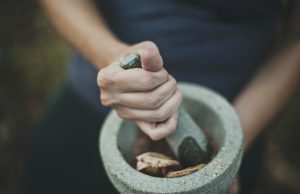
Dear reader, welcome to our latest article series on Ayurveda. In this series we will be covering what is Ayurveda, its origin and history, how did it become so popular in both Western and Eastern parts of the world, and the ongoing debate that has aroused as a result of the Government’s decision to allow Ayurvedic doctors to perform surgery.
The term Ayurveda, which means Knowledge of life in Sanskrit, is the gift of Hindu gods received by Rishis in India about 5000 years ago. At its core, the principle of Ayurveda states that the mind and the body are interconnected and the mind has the power to heal and transform a person’s mental as well as physical wellbeing.
_______________________________________________________________________
Read Also : The role of women in rural development, food production and poverty eradication
_______________________________________________________________________
How Did Ayurveda Begin?

Source: https://vediccure.com.au/About/history-of-ayurveda/2
Historians and experts of this field say that it was the Hindu God Brahma, one of the chief triumvirate gods of Hinduism, who created Ayurveda. Lord Brahma then transmitted this knowledge to his son, Daksha Prajapati, who further passed it on to the twin Vedic Gods, Ashwin Kumaras. The twin gods presented Ayurveda to the King of Gods, Lord Indra, who then passed it on to his disciples Acharya Bharadwaj, Acharya Kashyapa, and Aacharya Divodas Dhanvantari. Agnivesh, one of Bhardwaj’s disciples, developed the fundamental text of internal medicine based on the teachings of his Guru. And later, a student of Agnivesh, Acharya Charak, revised this body of work starting the tradition of passing down the knowledge of Ayurveda from gods to sages.
_______________________________________________________________________
Read Also : COVID-19 AND AYURVEDA
_______________________________________________________________________
Branches of Ayurveda

Ayurveda comprises eight branches, encompassing the holistic health of the Human Body. These branches further explain various functions and how to prevent and cure diseases in these areas.
- Kayachikitsa: this branch of Ayurveda deals with the overall treatment of the entire body. It focuses on the digestive system and metabolism. Procedures under this branch can be executed both internally and externally and include oral medicines or applying oils, lotions, and creams prescribed by the ayurvedic practitioner.
- Bala Chikitsa: Also known as Kaumara Bhritya, this branch of Ayurveda deals with a sickness that manifests in children and pre and postnatal care.
- Graha Chikitsa: Also known as Bhoot Vidya. This branch of Ayurveda deals with mental illness. Commonly practiced treatments under this branch include herbs, the recommended diet, yoga, deep breathing, and the mantra chikitsa (Chanting of Mantras).
- Urdhyaanga Chikitsa: This branch, also known as Shalakaya Tantra, is the Ayurvedic version of the E.N.T branch of modern medicine as it is primarily concerned with the issues in the upper parts of the body. Particularly the eyes, ears, nose, and throat.
- Shalyaroga Chikitsa: This branch of Ayurveda is concerned with carrying out surgical procedures using devices such as scalpels and scissors.
- Damstra Chikitsa: This branch of Ayurveda deals with studying and coming up with remedies for medicals cases involving toxins and poisons in the body, food, and the environment.
- Jara Chikitsa: This branch of Ayurveda deals with the care and treatment of the elderly. It focuses on the treatment of sickness and diseases brought on by old age. Therapies involve rejuvenation, longevity, memory, and strength.
- Vajikaran Chikitsa: This branch of Ayurveda is concerned with treating diseases related to sexual health, such as infertility and insufficient essential fluids.
Components of Ayurveda
Treatment of Ayurveda involves four major components.
- The Bishhak (Physician/surgeon)
- Rogi (Patient)
- Upasthata (Nurse/Caregiver)
- Dravyam (food/medicine)
All four components of Ayurveda as mentioned above have crucial roles to play for a successful diagnosis and treatment of diseases under Ayurveda.
Diagnosis and Treatment Under Ayurveda
Diagnosis under Ayurveda is conducted in two steps. The first step involves identifying the state and type of pathology. It can be conducted by carrying out health examinations and other investigations such as asking questions and assessing the patient.
The second step is concerned with the treatment of the patient. Based on the results from the previous step, the Ayurvedic practitioner determines the form of treatment to be prescribed or conducted.
There exist five types of treatment in Ayurvedic medicine based on the five primary senses of sight, sound, taste, touch, and smell. The ultimate goal of all these five methods is to bring balance to the patient’s dosha and can be done in any combination as prescribed by the practitioner.
_______________________________________________________________________
Read Also : Ayurveda and Modern Medicine: Are They Compatible?
_______________________________________________________________________
Ayurveda is one of the greatest gifts from India to the rest of the world. In fact, before India was invaded by foreign powers, the practice of Ayurveda had become a tremendously influential force for both the western as well as the eastern world. Ayurvedic texts were translated into Chinese in 400 CE, and Chinese scholars extensively studied the principles of ayurvedic medicine in 700 CE. It had also reached the shores of Greece, influencing the evolution of medicine in the country.
Stay tuned for the next article in our article series on Ayurveda!
Tags: #ayurveda, #ayurvedaeveryday, #ayurvedafood, #ayurvedalife, #ayurvedalifestyle, #ayurvedic, #ayurvedicmedicine, #health, #healthylifestyle, #india, #meditation, #natural, #vegan, #wellness, #yoga








Trackbacks/Pingbacks